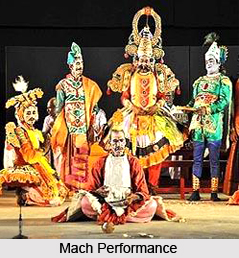 Mach is a traditional Hindi theatre of Madhya Pradesh presented largely through traditional songs and dances. The word Mach has been derived from Manch or `stage`. Mach is generally performed by the men and the themes are usually based on religious, historical, romantic, or social issues.
Mach is a traditional Hindi theatre of Madhya Pradesh presented largely through traditional songs and dances. The word Mach has been derived from Manch or `stage`. Mach is generally performed by the men and the themes are usually based on religious, historical, romantic, or social issues.
A comparatively young form said to have originated around the end of the eighteenth and early nineteenth centuries, Mach shares the secular nature and characteristics of other north Indian genres like Nautanki and Khyal. It was invented and developed by prominent artists like Guru Gopalji, Guru Balmukund, Kaluram Ustad, and Radhakrishan Ustad. They not only penned the scripts but also acted and managed the performances. Siddheshwar Sen is the most acclaimed recent exponent. About 125 manuscripts survive till now which include a few printed ones.
The open-air theatre consists of a platform nearly 4 m high and a canopy, simply but tastefully decorated. It is known to have been three-storied previously, with specific actions assigned for different levels. But only single and double stages exist now. The stage pole or khamb is put up about fifteen days before the performance with elaborate rituals to ensure success. Musicians` sit at the rear and a special place is assigned for the initiated, who also prompt the actors when they miss out words or actions. The show commences with an equivalent of the purvaranga, where characters like the bhishti or water carrier and farrasa or carpet spreader enact humorous pieces, followed by vandana or invocation to several deities. Chief among them are known as Ganesh and Bhairav. The entire actors move around in somewhat stylized gait to suitable introductions, and the main khel or play begins.
Apart from its delicate and evocative verse, the attraction of Mach lies in a highly evolved and theatrical musical structure. This combines with the classical and folk melodies of the region. That is the primary mode by which the narrative unfolds through the night. A systematic pattern exists in which certain tunes are used in certain situations known as rangats, of which there is a large variety. The two major accompanying instruments, dholak and sarangi, with well-defined rhythms and inventiveness respectively, play an equal part in evoking the magic.
While the stories involve heroes, a character called Sher Khan also acts the vidushaka or jester, creating humour while linking up the tales to topical incidents within the community. Costumes and jewellery are borrowed from the villagers and returned afterwards. In earlier days Mach performers, particularly actors playing female roles, were known to wear extremely heavy and genuine jewellery. This happened according to their characters and arranged by the community. Previously light came from torches, then from Petromax pressure lamps, and now through electricity. In the present days, the themes of Mach have become more social than mythological, but it faces an acute struggle for survival from exposure to newer and more glamorous media of entertainment.




















